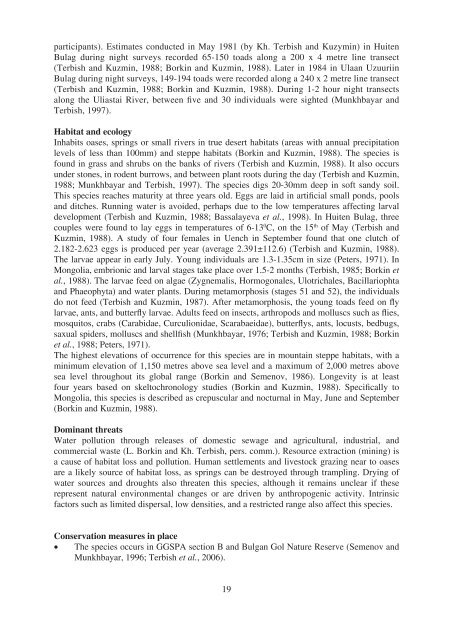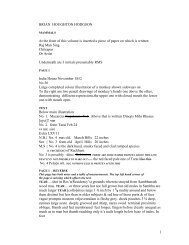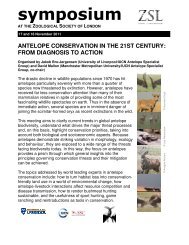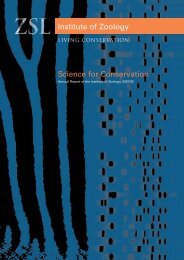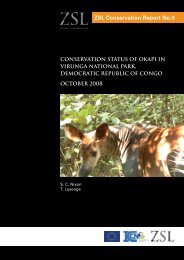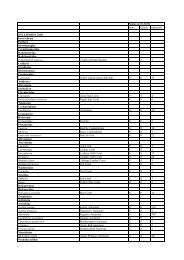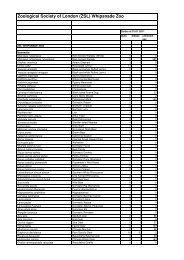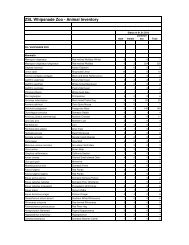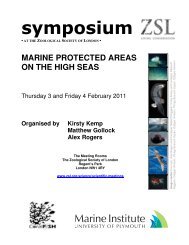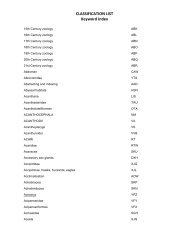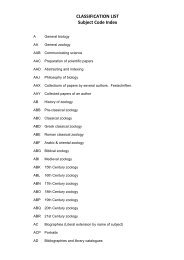Summary Conservation Action Plans for Mongolian Reptiles and ...
Summary Conservation Action Plans for Mongolian Reptiles and ...
Summary Conservation Action Plans for Mongolian Reptiles and ...
Create successful ePaper yourself
Turn your PDF publications into a flip-book with our unique Google optimized e-Paper software.
participants). Estimates conducted in May 1981 (by Kh. Terbish <strong>and</strong> Kuzymin) in Huiten<br />
Bulag during night surveys recorded 65-150 toads along a 200 x 4 metre line transect<br />
(Terbish <strong>and</strong> Kuzmin, 1988; Borkin <strong>and</strong> Kuzmin, 1988). Later in 1984 in Ulaan Uzuuriin<br />
Bulag during night surveys, 149-194 toads were recorded along a 240 x 2 metre line transect<br />
(Terbish <strong>and</strong> Kuzmin, 1988; Borkin <strong>and</strong> Kuzmin, 1988). During 1-2 hour night transects<br />
along the Uliastai River, between fi ve <strong>and</strong> 30 individuals were sighted (Munkhbayar <strong>and</strong><br />
Terbish, 1997).<br />
Habitat <strong>and</strong> ecology<br />
Inhabits oases, springs or small rivers in true desert habitats (areas with annual precipitation<br />
levels of less than 100mm) <strong>and</strong> steppe habitats (Borkin <strong>and</strong> Kuzmin, 1988). The species is<br />
found in grass <strong>and</strong> shrubs on the banks of rivers (Terbish <strong>and</strong> Kuzmin, 1988). It also occurs<br />
under stones, in rodent burrows, <strong>and</strong> between plant roots during the day (Terbish <strong>and</strong> Kuzmin,<br />
1988; Munkhbayar <strong>and</strong> Terbish, 1997). The species digs 20-30mm deep in soft s<strong>and</strong>y soil.<br />
This species reaches maturity at three years old. Eggs are laid in artifi cial small ponds, pools<br />
<strong>and</strong> ditches. Running water is avoided, perhaps due to the low temperatures affecting larval<br />
development (Terbish <strong>and</strong> Kuzmin, 1988; Bassalayeva et al., 1998). In Huiten Bulag, three<br />
couples were found to lay eggs in temperatures of 6-13 0 C, on the 15 th of May (Terbish <strong>and</strong><br />
Kuzmin, 1988). A study of four females in Uench in September found that one clutch of<br />
2.182-2.623 eggs is produced per year (average 2.391±112.6) (Terbish <strong>and</strong> Kuzmin, 1988).<br />
The larvae appear in early July. Young individuals are 1.3-1.35cm in size (Peters, 1971). In<br />
Mongolia, embrionic <strong>and</strong> larval stages take place over 1.5-2 months (Terbish, 1985; Borkin et<br />
al., 1988). The larvae feed on algae (Zygnemalis, Hormogonales, Ulotrichales, Bacillariophta<br />
<strong>and</strong> Phaeophyta) <strong>and</strong> water plants. During metamorphosis (stages 51 <strong>and</strong> 52), the individuals<br />
do not feed (Terbish <strong>and</strong> Kuzmin, 1987). After metamorphosis, the young toads feed on fl y<br />
larvae, ants, <strong>and</strong> butterfl y larvae. Adults feed on insects, arthropods <strong>and</strong> molluscs such as fl ies,<br />
mosquitos, crabs (Carabidae, Curculionidae, Scarabaeidae), butterfl ys, ants, locusts, bedbugs,<br />
saxual spiders, molluscs <strong>and</strong> shellfi sh (Munkhbayar, 1976; Terbish <strong>and</strong> Kuzmin, 1988; Borkin<br />
et al., 1988; Peters, 1971).<br />
The highest elevations of occurrence <strong>for</strong> this species are in mountain steppe habitats, with a<br />
minimum elevation of 1,150 metres above sea level <strong>and</strong> a maximum of 2,000 metres above<br />
sea level throughout its global range (Borkin <strong>and</strong> Semenov, 1986). Longevity is at least<br />
four years based on skeltochronology studies (Borkin <strong>and</strong> Kuzmin, 1988). Specifi cally to<br />
Mongolia, this species is described as crepuscular <strong>and</strong> nocturnal in May, June <strong>and</strong> September<br />
(Borkin <strong>and</strong> Kuzmin, 1988).<br />
Dominant threats<br />
Water pollution through releases of domestic sewage <strong>and</strong> agricultural, industrial, <strong>and</strong><br />
commercial waste (L. Borkin <strong>and</strong> Kh. Terbish, pers. comm.). Resource extraction (mining) is<br />
a cause of habitat loss <strong>and</strong> pollution. Human settlements <strong>and</strong> livestock grazing near to oases<br />
are a likely source of habitat loss, as springs can be destroyed through trampling. Drying of<br />
water sources <strong>and</strong> droughts also threaten this species, although it remains unclear if these<br />
represent natural environmental changes or are driven by anthropogenic activity. Intrinsic<br />
factors such as limited dispersal, low densities, <strong>and</strong> a restricted range also affect this species.<br />
<strong>Conservation</strong> measures in place<br />
• The species occurs in GGSPA section B <strong>and</strong> Bulgan Gol Nature Reserve (Semenov <strong>and</strong><br />
Munkhbayar, 1996; Terbish et al., 2006).<br />
19


